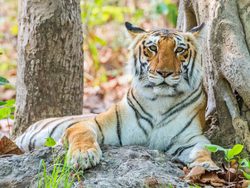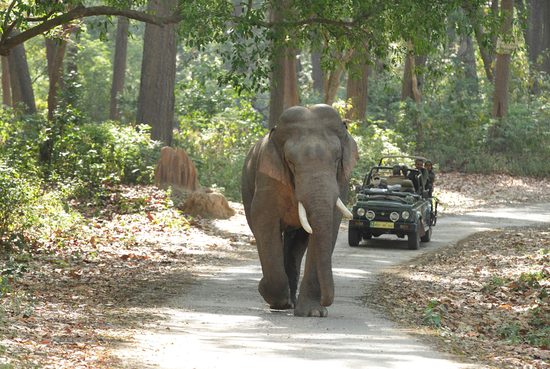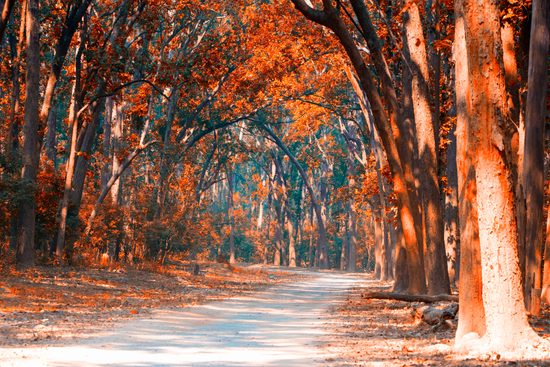
Jim Corbett National Park
Quick Navigation
Jim Corbett National Park is located in the northern part of India just northeast of New Delhi. The national park area covers an area of 201.1 square miles (520.8 sq km) and is part of the sub-Himalayan ecosystem. It is a GANP Ambassador Park.
An extended area beyond the park provides an additional protected buffer. This area was created to support the tigers, and the park was the first to be placed under the Project Tiger Initiative.
The elevation of the park fluctuates between 1,300 feet to 4,000 feet (400 to 1,220 m) above sea level. The elevation brings cooler evenings; however, the day delivers outstanding temperatures to explore the region. The elevation variations deliver an array of ravines, plateaus, ridges, valleys, streams and rivers.
Almost three-quarters of the park is encompassed by deciduous forest including peepal, rohini, and mango trees. There is a total of 110 species of trees making the forested area. Another 10% of the park is accounted for by grasslands. Altogether there are over 485 species of plants found within the boundaries of the park.
The varied vegetation of the park creates an excellent sanctuary for wildlife with around 50 species of mammals, 25 species of reptiles, and over 575 species of birds. The birds are complemented in the skies by 36 different species of dragonflies.
Tigers are one of the leading species of mammals that bring visitors to the parks with hopes of seeing these stunning creatures. Spotting tigers is a challenge because of the abundance of thick vegetation.
Other predator species include leopards, jungle cats, fishing cats, and the leopard cat. Popular mammalian species include elephants, water buffalo, barking deer, sambar deer, chital, black bears, mongoose, rhesus macaques, and hog deer.
Crocodiles and gharials have regenerated eroding populations for a stronger presence in the park. The Indian python is a notorious reptile that can kill almost any of the species found in Jim Corbett National Park.
Although wildlife is the primary appeal of the park, it is not the only encounter with nature that people remember. Corbett Falls reaches a height of 66 feet (20 m) and is nestled in the dense jungle. The sounds of the falls are the only sounds you will hear when experiencing the falls.
Garjiva Devi Temple is a revered temple situated on the riverbank of the river Kosi. This is just an added cultural and historical feature of the national park. Kalagarh Dam is an architectural feature within the park boundaries which creates an amazing place for bird lovers to spot a variety of birds and waterfowl from both local and migratory species.
Highlights
 The wildlife of the national park is the immediate attraction and the highlight of all visitors. It is the wildlife that draws them to experience the Jim Corbett National Park.
The wildlife of the national park is the immediate attraction and the highlight of all visitors. It is the wildlife that draws them to experience the Jim Corbett National Park.
Taking a jeep safari is the most common and most popular way to experience the abundance of nature Jim Corbett National Park has to offer. The jeep safari affords visitors with the best chances of seeing the most wildlife, which is why most people come to the park.
There are over 70,000 visitors to the park every year that are fortunate to experience the wildlife found in the region. Visitors can explore via Jeep safari, Canter safari, or elephant safari.
Things To Do:
Jim Corbett National Park is one of the favorite destinations in India for seeing wildlife. There is more than one way to do it.

Game Drive
The most common activity in the park is the game drive. This gives you the best chances for seeing a variety and abundance of wildlife found within the park borders.

Walking Safari
Guided by a registered park representative, a walking safari is a way to get outdoors and experience the splendor of the national park. This is a more personal encounter with nature, but wildlife viewing is usually more productive from within one of the vehicles.
Jim Corbett National Park Trails
There are no trails for hiking in the park because of the abundance of wildlife. However, trekking is permitted with the assistance of a registered park guide. You can explore the park on foot using one of guided walking safaris.
Jim Corbett Highlights
- Tigers
- Elephant, crocodile, and the Indian python
- An array of deer species
- Corbett Falls
Park Map
Sources
- Britannica, Corbet National Park, https://www.britannica.com/place/Corbett-National-Park, retrieved March 2020.
- Corbett National Park, park site, https://www.corbett-national-park.com/, retrieved March 2020.
- Corbett Nationalpark.in, park site, https://www.corbettnationalpark.in/, retrieved March 2020.
- Travelogy India, Jim Corbett National Park, https://www.travelogyindia.com/wildlife-tours/national-park/jim-corbett-national-park.html, retrieved March 2020.
- Uttarakhand Tourism Department, Corbett National Park, https://uttarakhandtourism.gov.in/activity/corbett-national-park-2/, retrieved March 2020.















